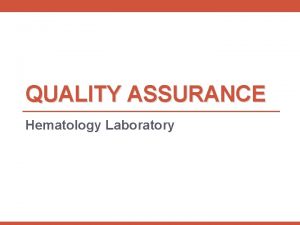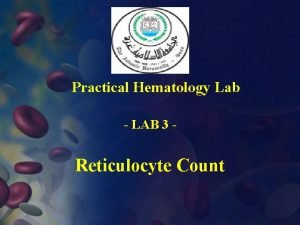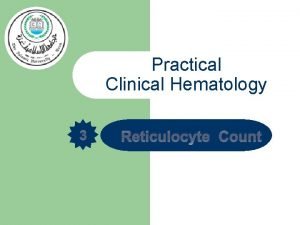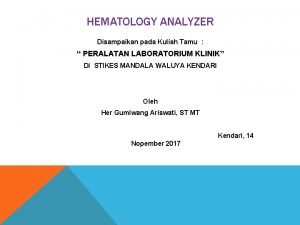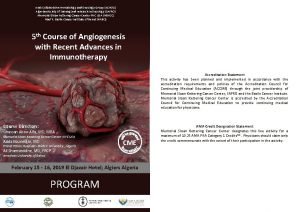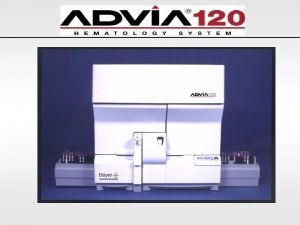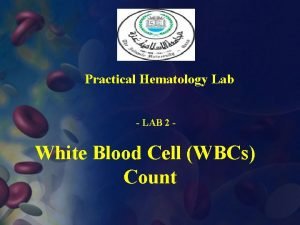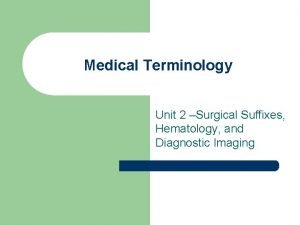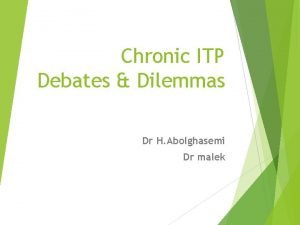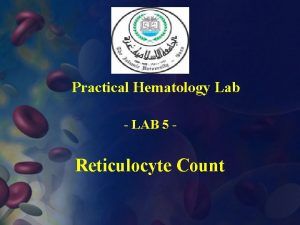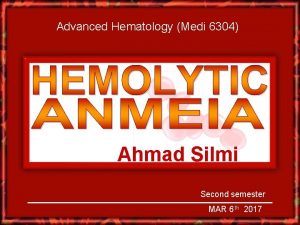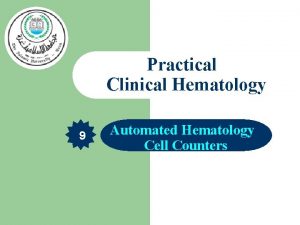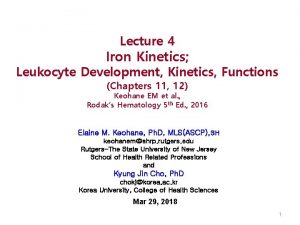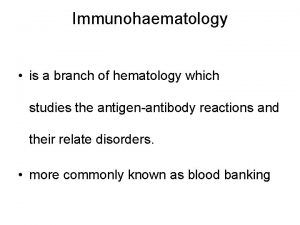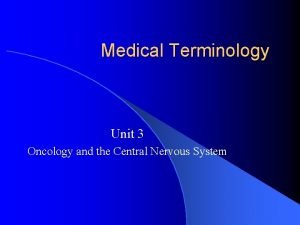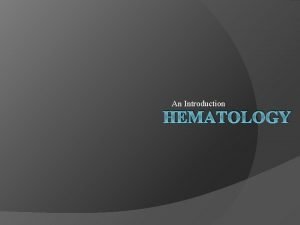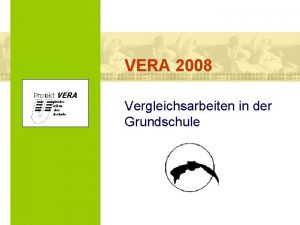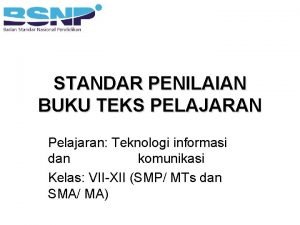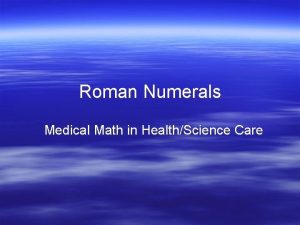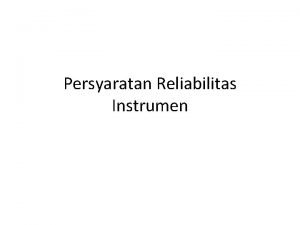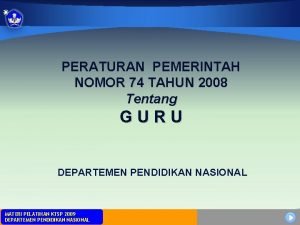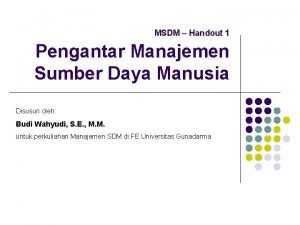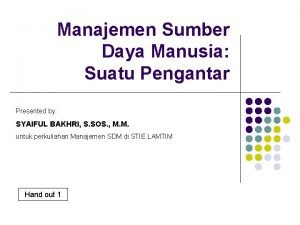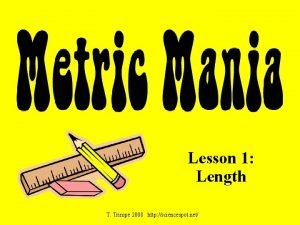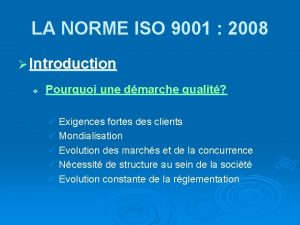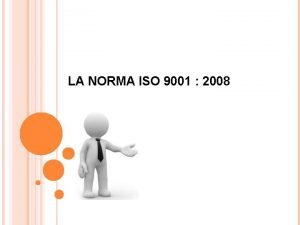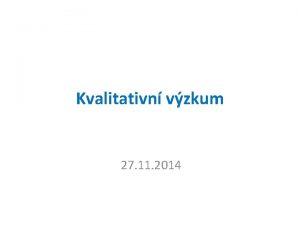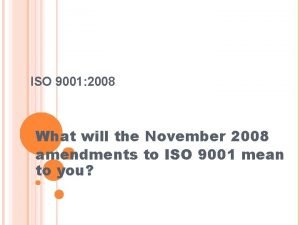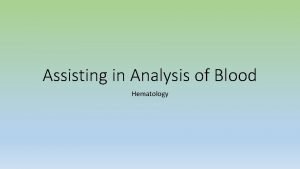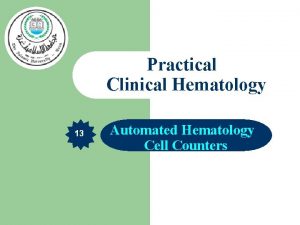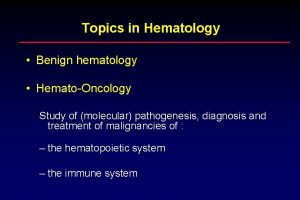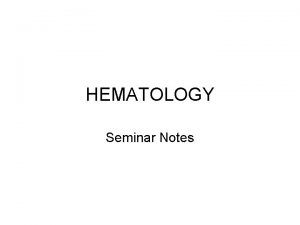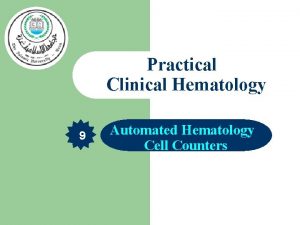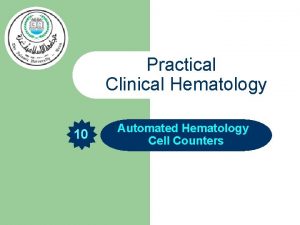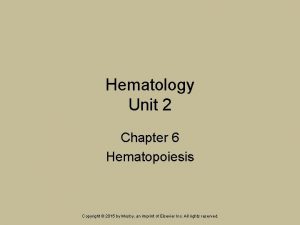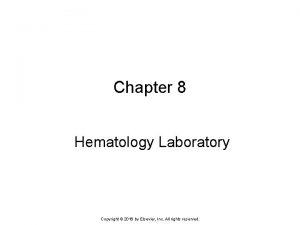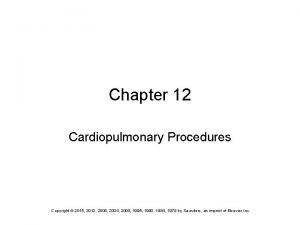Chapter 18 Hematology Copyright 2018 2015 2012 2008

















































































- Slides: 81

Chapter 18 Hematology Copyright © 2018, 2015, 2012, 2008, 2004, 2000, 1995, 1990, 1984, 1979 by Saunders, an imprint of Elsevier Inc.

Lesson 18. 1 Hematology Tests 1. 2. 3. 4. List the tests included in a complete blood count. Describe the shape of an erythrocyte, and explain how it acquires this shape. Describe the composition of hemoglobin, and explain its function. Describe the normal appearance of leukocytes, and explain how they fight infection in the body. Copyright © 2018, 2015, 2012, 2008, 2004, 2000, 1995, 1990, 1984, 1979 by Saunders, an imprint of Elsevier Inc. 2

Lesson 18. 1 Hematology Tests 5. State the reference range for each of the following hematologic tests: • • • Hemoglobin Hematocrit Red and white blood cell counts Differential cell count Platelet count PT/INR Copyright © 2018, 2015, 2012, 2008, 2004, 2000, 1995, 1990, 1984, 1979 by Saunders, an imprint of Elsevier Inc. 3

Lesson 18. 1 Hematology Tests 6. 7. 8. 9. 10. 11. State the purpose of the hematocrit, and list the layers into which the blood separates after it has been centrifuged. Explain how the red blood count (RBC) indices can help diagnose the various types of anemia. Explain the purpose of the differential cell count. Describe the appearance of the five types of white blood cells. State the purpose of the PT/INR test. List the advantages of PT/INR home testing. Copyright © 2018, 2015, 2012, 2008, 2004, 2000, 1995, 1990, 1984, 1979 by Saunders, an imprint of Elsevier Inc. 4

Introduction to Hematology (1 of 8) Hematology: the study of blood Ø Includes: • • • Morphologic appearance of blood cells Function of blood cells Diseases of the blood and blood-forming tissues Copyright © 2018, 2015, 2012, 2008, 2004, 2000, 1995, 1990, 1984, 1979 by Saunders, an imprint of Elsevier Inc. 5

Introduction to Hematology (2 of 8) Laboratory analysis in hematology Ø Ø Purpose: Examining blood to detect pathologic conditions Includes • • • Ø Performing blood cell counts Evaluating the clotting ability of blood Identifying cell types Determines if each blood component falls within its reference range Copyright © 2018, 2015, 2012, 2008, 2004, 2000, 1995, 1990, 1984, 1979 by Saunders, an imprint of Elsevier Inc. 6

Introduction to Hematology (3 of 8) Specific hematology tests Ø Ø Ø Hemoglobin (Hgb or Hb) Hematocrit (Hct) White blood cell (WBC) count Copyright © 2018, 2015, 2012, 2008, 2004, 2000, 1995, 1990, 1984, 1979 by Saunders, an imprint of Elsevier Inc. 7

Introduction to Hematology (4 of 8) Specific hematology tests Ø Ø Red blood cell (RBC) count Differential white blood cell count (diff) Erythrocyte sedimentation rate (ESR) Platelet count (Plt) Copyright © 2018, 2015, 2012, 2008, 2004, 2000, 1995, 1990, 1984, 1979 by Saunders, an imprint of Elsevier Inc. 8

Introduction to Hematology (5 of 8) Hematology tests Ø Ø May be performed in the medical office CLIA-waived automated blood analyzers designed for the medical office • Perform laboratory tests with accurate test results and in a short time Copyright © 2018, 2015, 2012, 2008, 2004, 2000, 1995, 1990, 1984, 1979 by Saunders, an imprint of Elsevier Inc. 9

Introduction to Hematology (6 of 8) Hematology tests Ø CLIA-waived automated blood analyzers designed for the medical office • Operating manual accompanies each analyzer – information included: operation; test parameters; care and maintenance Copyright © 2018, 2015, 2012, 2008, 2004, 2000, 1995, 1990, 1984, 1979 by Saunders, an imprint of Elsevier Inc. 10

Introduction to Hematology (7 of 8) Complete blood count (CBC) Ø Most frequently performed hematological test – performed on • • New patients Patients with a pathologic condition Copyright © 2018, 2015, 2012, 2008, 2004, 2000, 1995, 1990, 1984, 1979 by Saunders, an imprint of Elsevier Inc. 11

Introduction to Hematology (8 of 8) Complete blood count (CBC) Ø Tests included in a CBC • • White blood cell (WBC) count Red blood cell (RBC) count Platelet count Hemoglobin (Hgb or Hb) Hematocrit (Hct) Differential white blood cell count (diff) Red blood cell indices Copyright © 2018, 2015, 2012, 2008, 2004, 2000, 1995, 1990, 1984, 1979 by Saunders, an imprint of Elsevier Inc. 12

Components and Function of Blood consists of two parts: Ø Ø Plasma: liquid portion Cells: solid portion Average adult body: 10 to 12 pints of blood Copyright © 2018, 2015, 2012, 2008, 2004, 2000, 1995, 1990, 1984, 1979 by Saunders, an imprint of Elsevier Inc. 13

Erythrocytes (1 of 4) In an adult: formed in red bone marrow of Ø Ø Ø Ribs Sternum Skull Pelvic bone Ends of long bones of limbs Copyright © 2018, 2015, 2012, 2008, 2004, 2000, 1995, 1990, 1984, 1979 by Saunders, an imprint of Elsevier Inc. 14

Erythrocytes (2 of 4) Immature form: contains a nucleus Ø As RBC matures: • • Loses nucleus as the cell matures Acquires shape of a biconcave disc Red blood count range: Ø Ø Women: 4 to 5. 5 million/mm 3 of blood Men: 4. 5 to 6. 2 million/mm 3 of blood Copyright © 2018, 2015, 2012, 2008, 2004, 2000, 1995, 1990, 1984, 1979 by Saunders, an imprint of Elsevier Inc. 15

Erythrocytes (3 of 4) Hemoglobin Ø Ø Makes up major portion of erythrocyte Transports oxygen Responsible for red color of RBC Hemoglobin molecule consists of: • • Globin: protein Heme: iron-containing pigment Copyright © 2018, 2015, 2012, 2008, 2004, 2000, 1995, 1990, 1984, 1979 by Saunders, an imprint of Elsevier Inc. 16

Erythrocytes (4 of 4) Average life span of RBC: 120 days Ø Hemolysis: breakdown of RBCs • • RBC becomes fragile and ruptures Hemoglobin is released from RBC Copyright © 2018, 2015, 2012, 2008, 2004, 2000, 1995, 1990, 1984, 1979 by Saunders, an imprint of Elsevier Inc. 17

Leukocytes (1 of 3) Clear, colorless cells that contain a nucleus Adult normal range: 4, 500 to 11, 000/mm 3 of blood Leukocytosis: An abnormal increase in the number of leukocytes Leukopenia: An abnormal decrease in the number of leukocytes Copyright © 2018, 2015, 2012, 2008, 2004, 2000, 1995, 1990, 1984, 1979 by Saunders, an imprint of Elsevier Inc. 18

Leukocytes (2 of 3) Function of leukocytes: defend body against infection Ø Ø Destroy invading pathogens Remove them from the body WBCs do their work in the tissues Ø Transported to site of infection by the circulatory system Copyright © 2018, 2015, 2012, 2008, 2004, 2000, 1995, 1990, 1984, 1979 by Saunders, an imprint of Elsevier Inc. 19

Leukocytes (3 of 3) Some white blood cells exhibit phagocytosis: Ø Ø Ø Engulf pathogens Destroy damaged cells Copyright © 2018, 2015, 2012, 2008, 2004, 2000, 1995, 1990, 1984, 1979 by Saunders, an imprint of Elsevier Inc. 20

Thrombocytes (1 of 2) Also known as platelets Small, clear, and shaped like discs Do not have a nucleus Copyright © 2018, 2015, 2012, 2008, 2004, 2000, 1995, 1990, 1984, 1979 by Saunders, an imprint of Elsevier Inc. 21

Thrombocytes (2 of 2) Formed in red bone marrow Function: participate in blood-clotting mechanism Adult normal range: 150, 000 to 400, 000/mm 3 of blood Copyright © 2018, 2015, 2012, 2008, 2004, 2000, 1995, 1990, 1984, 1979 by Saunders, an imprint of Elsevier Inc. 22

Hemoglobin Determination (1 of 8) Hemoglobin (Hgb): major component of RBCs Hemoglobin transports oxygen to tissue cells Responsible for red color of RBCs Copyright © 2018, 2015, 2012, 2008, 2004, 2000, 1995, 1990, 1984, 1979 by Saunders, an imprint of Elsevier Inc. 23

Hemoglobin Determination (2 of 8) Normal range Ø Ø Adult female: 12 to 16 g/d. L Adult male: 14 to 18 g/d. L Hemoglobin performed as individual test or as part of CBC Copyright © 2018, 2015, 2012, 2008, 2004, 2000, 1995, 1990, 1984, 1979 by Saunders, an imprint of Elsevier Inc. 24

Hemoglobin Determination (3 of 8) Decreased hemoglobin level: occurs with Ø Ø Anemia (especially iron-deficiency anemia) Hyperthyroidism Cirrhosis of the liver Severe hemorrhaging Copyright © 2018, 2015, 2012, 2008, 2004, 2000, 1995, 1990, 1984, 1979 by Saunders, an imprint of Elsevier Inc. 25

Hemoglobin Determination (4 of 8) Decreased hemoglobin level: occurs with Ø Ø Hemolytic reactions Certain systemic diseases • • Leukemia Hodgkin's disease Copyright © 2018, 2015, 2012, 2008, 2004, 2000, 1995, 1990, 1984, 1979 by Saunders, an imprint of Elsevier Inc. 26

Hemoglobin Determination (5 of 8) Increased hemoglobin level occurs with Ø Ø Ø Polycythemia COPD CHF Copyright © 2018, 2015, 2012, 2008, 2004, 2000, 1995, 1990, 1984, 1979 by Saunders, an imprint of Elsevier Inc. 27

Hemoglobin Determination (6 of 8) CLIA-waived hemoglobin analyzer Ø Ø Used to measure hemoglobin in the medical office Permits processing of the specimen in a short time • Ø Ø With accurate and reliable test results Allows provider to evaluate the condition while patient is still at office Requires only a finger puncture to perform test rather than venipuncture Copyright © 2018, 2015, 2012, 2008, 2004, 2000, 1995, 1990, 1984, 1979 by Saunders, an imprint of Elsevier Inc. 28

Hemoglobin Determination (7 of 8) CLIA-waived hemoglobin analyzer Ø Manufacturer provides an operating manual that includes: • • • Information to perform quality control procedures – important to ensure analyzer is functioning properly Precautions to take when running test Storage and stability of testing devices and control reagents Collection of specimen Procedure for testing the specimen Copyright © 2018, 2015, 2012, 2008, 2004, 2000, 1995, 1990, 1984, 1979 by Saunders, an imprint of Elsevier Inc. 29

Hemoglobin Determination (8 of 8) CLIA-waived hemoglobin analyzer Ø Follow hemoglobin procedure exactly as presented in the operating manual: • • • Testing device placed in analyzer Skin puncture is performed Drop of blood placed on testing device Analyzer determines hemoglobin results Results displayed on screen of analyzer Copyright © 2018, 2015, 2012, 2008, 2004, 2000, 1995, 1990, 1984, 1979 by Saunders, an imprint of Elsevier Inc. 30

Hematocrit (1 of 7) Abbreviated Hct Hematocrit means "to separate blood" Ø Solid cellular elements separated from plasma • Ø By centrifuging an anticoagulated blood specimen Heavier RBCs become packed and settle to bottom of the tube Copyright © 2018, 2015, 2012, 2008, 2004, 2000, 1995, 1990, 1984, 1979 by Saunders, an imprint of Elsevier Inc. 31

Hematocrit (2 of 7) Hematocrit means "to separate blood" Ø Ø Top layer: contains clear, straw-colored plasma Between layers is small, thin, yellowish-gray layer • Buffy coat: contains platelets and WBCs Copyright © 2018, 2015, 2012, 2008, 2004, 2000, 1995, 1990, 1984, 1979 by Saunders, an imprint of Elsevier Inc. 32

Hematocrit (3 of 7) Copyright © 2018, 2015, 2012, 2008, 2004, 2000, 1995, 1990, 1984, 1979 by Saunders, an imprint of Elsevier Inc. 33

Hematocrit (4 of 7) Purpose of hematocrit: measures percentage of packed RBCs in whole blood Normal range Ø Ø Women: 37% to 47% Men: 40% to 54% Copyright © 2018, 2015, 2012, 2008, 2004, 2000, 1995, 1990, 1984, 1979 by Saunders, an imprint of Elsevier Inc. 34

Hematocrit (5 of 7) Low reading: may indicate anemia High reading: may indicate polycythemia Used with other tests to diagnose patient's condition Copyright © 2018, 2015, 2012, 2008, 2004, 2000, 1995, 1990, 1984, 1979 by Saunders, an imprint of Elsevier Inc. 35

Hematocrit (6 of 7) Microhematocrit method Ø Ø Most often used in the medical office Blood obtained by skin puncture • Ø Using a disposable capillary tube lined with anticoagulant Blood drawn into the capillary tube • Sealed with a sealing compound Copyright © 2018, 2015, 2012, 2008, 2004, 2000, 1995, 1990, 1984, 1979 by Saunders, an imprint of Elsevier Inc. 36

Hematocrit (7 of 7) Microhematocrit method Ø Centrifuged for 3 to 5 minutes • Packs the RBCs Results read at top of the packed cell column Copyright © 2018, 2015, 2012, 2008, 2004, 2000, 1995, 1990, 1984, 1979 by Saunders, an imprint of Elsevier Inc. 37

White Blood Cell Count (1 of 6) Approximate measurement of number of WBCs in circulating blood Adult reference range: 4, 500 to 11, 000 WBC/mm 3 of blood Ø Expressed as 4. 5 to 11. 0 (x 103/mm 3) on laboratory reports Copyright © 2018, 2015, 2012, 2008, 2004, 2000, 1995, 1990, 1984, 1979 by Saunders, an imprint of Elsevier Inc. 38

White Blood Cell Count (2 of 6) Leukocytosis: increase in the number of WBCs (greater than 11, 000) Ø Most commonly seen in acute infections: • • • Appendicitis Chicken pox Diphtheria Infectious mononucleosis Meningitis Rheumatic fever Copyright © 2018, 2015, 2012, 2008, 2004, 2000, 1995, 1990, 1984, 1979 by Saunders, an imprint of Elsevier Inc. 39

White Blood Cell Count (3 of 6) Leukocytosis: increase in the number of WBCs (greater than 11, 000) Ø Normal elevation can occur in: • • Pregnancy Strenuous exercise Stress Treatment with corticosteroids Copyright © 2018, 2015, 2012, 2008, 2004, 2000, 1995, 1990, 1984, 1979 by Saunders, an imprint of Elsevier Inc. 40

White Blood Cell Count (4 of 6) Leukopenia: decreased WBC Ø Ø Ø Viral infections Chemotherapy Radiation therapy Copyright © 2018, 2015, 2012, 2008, 2004, 2000, 1995, 1990, 1984, 1979 by Saunders, an imprint of Elsevier Inc. 41

White Blood Cell Count (5 of 6) If WBC count is performed in the medical office Ø CLIA-nonwaived automated blood cell counter must be used • Moderately complex test Copyright © 2018, 2015, 2012, 2008, 2004, 2000, 1995, 1990, 1984, 1979 by Saunders, an imprint of Elsevier Inc. 42

White Blood Cell Count (6 of 6) Blood cell counter: Ø Can also perform • • • RBC count Platelet count Hemoglobin Hematocrit Differential WBC count Calculation of RBC indices Copyright © 2018, 2015, 2012, 2008, 2004, 2000, 1995, 1990, 1984, 1979 by Saunders, an imprint of Elsevier Inc. 43

Red Blood Cell Count (1 of 3) Measurement of number of RBCs in whole blood Normal range Ø Women: 4 to 5. 5 million/mm 3 of blood • Ø On laboratory report expressed as 4 to 5. 5 (x 106 mm 3) Men: 4. 5 to 6. 2 million/mm 3 of blood • On laboratory report expressed as 4. 5 to 6. 2 (x 106 mm 3) Copyright © 2018, 2015, 2012, 2008, 2004, 2000, 1995, 1990, 1984, 1979 by Saunders, an imprint of Elsevier Inc. 44

Red Blood Cell Count (2 of 3) Performed using blood cell counter Decrease in red blood cell count Ø Ø Ø Anemia Hodgkin's disease Leukemia Copyright © 2018, 2015, 2012, 2008, 2004, 2000, 1995, 1990, 1984, 1979 by Saunders, an imprint of Elsevier Inc. 45

Red Blood Cell Count (3 of 3) Increase in red blood count Ø Ø Ø Polycythemia Dehydration Pulmonary fibrosis Copyright © 2018, 2015, 2012, 2008, 2004, 2000, 1995, 1990, 1984, 1979 by Saunders, an imprint of Elsevier Inc. 46

Red Blood Cell Indices (1 of 3) Measurements that are reported as part of the CBC Provide information about the size and hemoglobin content of red blood cells Obtained from calculations performed on certain test results included in a CBC Ø Ø RBC count, hemoglobin, and hematocrit Calculation automatically performed by blood cell analyzer that performs CBC Copyright © 2018, 2015, 2012, 2008, 2004, 2000, 1995, 1990, 1984, 1979 by Saunders, an imprint of Elsevier Inc. 47

Red Blood Cell Indices (2 of 3) Anemia: Decrease in the number of red blood cells or the amount of hemoglobin Ø Are over 400 types of anemia • Ø Many are rare conditions Each of the various forms of anemia (e. g. , irondeficiency anemia, pernicious anemia) may alter one or more of the RBC indices • This information is used to assist in the diagnosis of the type of anemia present Copyright © 2018, 2015, 2012, 2008, 2004, 2000, 1995, 1990, 1984, 1979 by Saunders, an imprint of Elsevier Inc. 48

Red Blood Cell Indices (3 of 3) RBC indices include: Ø Ø MCV: Mean corpuscular volume MCH Mean corpuscular hemoglobin MCHC: Mean cell hemoglobin concentration RDW: Red cell distribution width Copyright © 2018, 2015, 2012, 2008, 2004, 2000, 1995, 1990, 1984, 1979 by Saunders, an imprint of Elsevier Inc. 49

White Blood Cell Differential Count (1 of 3) Five types of WBCs, each having a certain: Ø Ø Appearance Size Shape Function Copyright © 2018, 2015, 2012, 2008, 2004, 2000, 1995, 1990, 1984, 1979 by Saunders, an imprint of Elsevier Inc. 50

White Blood Cell Differential Count (2 of 3) Purpose of differential Ø To identify and count the five types of WBCs in a representative blood sample • Increase or decrease in one or more types – assists provider in making a diagnosis Copyright © 2018, 2015, 2012, 2008, 2004, 2000, 1995, 1990, 1984, 1979 by Saunders, an imprint of Elsevier Inc. 51

White Blood Cell Differential Count (3 of 3) Can be performed automatically or manually Ø Manual method • Allows for closer inspection of abnormal white blood cells Automatic analyzer flags abnormalities Ø Laboratory then performs a manual differential count Copyright © 2018, 2015, 2012, 2008, 2004, 2000, 1995, 1990, 1984, 1979 by Saunders, an imprint of Elsevier Inc. 52

Automatic Method Blood cell counter used (e. g. , Coulter counter) Specimen requirement Ø EDTA-anticoagulated blood specimen • Lavender-stoppered tube Blood cell counter automatically performs differential count Ø Prints results on a laboratory report Copyright © 2018, 2015, 2012, 2008, 2004, 2000, 1995, 1990, 1984, 1979 by Saunders, an imprint of Elsevier Inc. 53

Manual Method (1 of 3) Blood specimen can be made from: Ø Ø Fresh whole blood (preferred) EDTA-anticoagulated blood • Smear must be made within 24 hours after collection Other anticoagulants alter Ø Ø Morphology of WBCs Staining reaction of WBCs Copyright © 2018, 2015, 2012, 2008, 2004, 2000, 1995, 1990, 1984, 1979 by Saunders, an imprint of Elsevier Inc. 54

Manual Method (2 of 3) MA makes two blood smears Slides placed in a protective container for transport to outside laboratory Laboratory personnel stain smear (Wright's stain) Ø Ø Because WBCs are clear and colorless After staining • Nucleus, cytoplasm, and granules take characteristic color of their cell type – aids in identification of the five different types of white blood cells Copyright © 2018, 2015, 2012, 2008, 2004, 2000, 1995, 1990, 1984, 1979 by Saunders, an imprint of Elsevier Inc. 55

Manual Method (3 of 3) Number of each type is recorded as a percentage Reflects overall distribution of WBCs in patient's blood Slide also examined for: Ø Abnormalities in RBC morphology Copyright © 2018, 2015, 2012, 2008, 2004, 2000, 1995, 1990, 1984, 1979 by Saunders, an imprint of Elsevier Inc. 56

Types of White Blood Cells (1 of 2) Classified into two categories Ø Granular: contain distinct granules in the cytoplasm: • • • Neutrophils Eosinophils Basophils Copyright © 2018, 2015, 2012, 2008, 2004, 2000, 1995, 1990, 1984, 1979 by Saunders, an imprint of Elsevier Inc. 57

Types of White Blood Cells (2 of 2) Nongranular: few or no granules in the cytoplasm: Ø Ø Lymphocytes Monocytes Copyright © 2018, 2015, 2012, 2008, 2004, 2000, 1995, 1990, 1984, 1979 by Saunders, an imprint of Elsevier Inc. 58

Reference Range Normal range for diff count: Ø Ø Ø Neutrophils: 40% to 75% Eosinophils: 1% to 6% Basophils: 0% to 2% Lymphocytes: 20% to 40% Monocytes: 3% to 10% Copyright © 2018, 2015, 2012, 2008, 2004, 2000, 1995, 1990, 1984, 1979 by Saunders, an imprint of Elsevier Inc. 59

PT/INR (1 of 5) Combination of: Ø Ø PT (prothrombin time) test Mathematical calculation Calculation performed on PT test Ø To arrive at a standardized value • Known as an INR (International Normalized Ratio) Copyright © 2018, 2015, 2012, 2008, 2004, 2000, 1995, 1990, 1984, 1979 by Saunders, an imprint of Elsevier Inc. 60

PT/INR (2 of 5) PT test Ø Ø Measures how long it takes blood to clot Results measured in seconds Copyright © 2018, 2015, 2012, 2008, 2004, 2000, 1995, 1990, 1984, 1979 by Saunders, an imprint of Elsevier Inc. 61

PT/INR (3 of 5) Variety of testing reagents can be used to measure PT Ø Ø Ø Each works in a different way to assess the clotting ability of blood PT result obtained when using one reagent cannot be compared to PT results tested using a different reagent To account for differences • Coagulation analyzer converts results to standardized ratio (known as INR) Copyright © 2018, 2015, 2012, 2008, 2004, 2000, 1995, 1990, 1984, 1979 by Saunders, an imprint of Elsevier Inc. 62

PT/INR (4 of 5) PT/INR result Ø Ø Ø Expressed as a number because value is a ratio Does not have a unit of measurement attached to it Healthy individual with a normal clotting ability • Should have a PT/INR result that falls between 0. 8 and 1. 2 Copyright © 2018, 2015, 2012, 2008, 2004, 2000, 1995, 1990, 1984, 1979 by Saunders, an imprint of Elsevier Inc. 63

PT/INR (5 of 5) PT/INR result Ø Higher the number: the longer it takes for blood to clot • Ø Example: PT/INR of 3. 0 – blood would take longer to clot than an individual with a PT/INR of 1. 0 Risk of spontaneous bleeding: begins to rise dramatically as INR reaches 4. 0 or higher Copyright © 2018, 2015, 2012, 2008, 2004, 2000, 1995, 1990, 1984, 1979 by Saunders, an imprint of Elsevier Inc. 64

Purpose (1 of 7) Most commonly performed on patients undergoing long-term warfarin therapy Warfarin Ø Brand names • • Ø Ø Coumadin Jantoven Anticoagulant that inhibits the formation of blood clots in the body Interferes with the blood clotting mechanism in the body • Takes blood longer to clot Copyright © 2018, 2015, 2012, 2008, 2004, 2000, 1995, 1990, 1984, 1979 by Saunders, an imprint of Elsevier Inc. 65

Purpose (2 of 7) PT/INR test: measures effect that warfarin has on the clotting ability of the blood Warfarin prescribed for patients who are likely to form clots: Ø Ø Ø Heart attack Stroke Thrombophlebitis: also known as deep vein thrombosis (DVT) Copyright © 2018, 2015, 2012, 2008, 2004, 2000, 1995, 1990, 1984, 1979 by Saunders, an imprint of Elsevier Inc. 66

Purpose (3 of 7) Warfarin prescribed for patients who are likely to form clots: Ø Atrial fibrillation: Irregular heartbeat that can cause blood to pool in the heart • Ø May cause a blood clot to form – can travel to the brain: resulting in a stroke Heart valve replaced with a mechanical valve • Increased risk of clot forming on a mechanical valve – may cause a heart blockage Copyright © 2018, 2015, 2012, 2008, 2004, 2000, 1995, 1990, 1984, 1979 by Saunders, an imprint of Elsevier Inc. 67

Purpose (4 of 7) PT/INR test also ordered on patients exhibiting signs and symptoms of a coagulation disorder Ø Ø Ø Unexplained nosebleeds Excessive bleeding from gums Easy bruising Heavy menstrual periods Unexplained blood in the stool or urine Copyright © 2018, 2015, 2012, 2008, 2004, 2000, 1995, 1990, 1984, 1979 by Saunders, an imprint of Elsevier Inc. 68

Purpose (5 of 7) Provider determines PT/INR range for patient on long-term warfarin therapy Ø Depends on condition being treated Copyright © 2018, 2015, 2012, 2008, 2004, 2000, 1995, 1990, 1984, 1979 by Saunders, an imprint of Elsevier Inc. 69

Purpose (6 of 7) Goal of warfarin therapy Ø Increase clotting time to a level that prevents formation of blood clots • Without causing excessive bleeding or bruising Patient must undergo periodic PT/INR testing Ø To ensure patient remains in his or her ideal PT/INR range • Minimizes complications of warfarin therapy Copyright © 2018, 2015, 2012, 2008, 2004, 2000, 1995, 1990, 1984, 1979 by Saunders, an imprint of Elsevier Inc. 70

Purpose (7 of 7) Frequency of testing depends on: Ø Ø Stability of patient’s previous test results Occurrence of conditions that may cause test results to fall outside of the patient’s desired range Copyright © 2018, 2015, 2012, 2008, 2004, 2000, 1995, 1990, 1984, 1979 by Saunders, an imprint of Elsevier Inc. 71

Collection of the Specimen (1 of 3) Requires a small (4 to 5 ml) tube of blood Must collect in a sodium citrate tube (light blue) Sodium citrate Ø Prevents specimen from clotting without affecting test results Copyright © 2018, 2015, 2012, 2008, 2004, 2000, 1995, 1990, 1984, 1979 by Saunders, an imprint of Elsevier Inc. 72

Collection of the Specimen (2 of 3) Butterfly method Ø Draw a 5 -ml red-stoppered discard tube first (before light blue tube) • Ø To prevent air in tubing from entering the light blue tube If light blue-stoppered tube is filled first • Results in an incorrect anticoagulant-to-blood ratio – leads to inaccurate test results Copyright © 2018, 2015, 2012, 2008, 2004, 2000, 1995, 1990, 1984, 1979 by Saunders, an imprint of Elsevier Inc. 73

Collection of the Specimen (3 of 3) Important to fill tube to the exhaustion of the vacuum Ø Most light blue tubes have a fill indicator Ø Underfilled tube: leads to inaccurate test results To determine if tube has been completely filled Once tube has been drawn Ø Immediately and gently invert it three or four times • To mix anticoagulant with blood Place in a biohazard specimen bag along with a laboratory request Ø For pickup by laboratory courier Copyright © 2018, 2015, 2012, 2008, 2004, 2000, 1995, 1990, 1984, 1979 by Saunders, an imprint of Elsevier Inc. 74

Performing a PT/INR Test (1 of 3) CLIA-waived handheld coagulation analyzers are commercially available Ø For performing a PT/INR test in the medical office Advantage of coagulation analyzers Ø Require only a finger puncture (rather than a venipuncture) Copyright © 2018, 2015, 2012, 2008, 2004, 2000, 1995, 1990, 1984, 1979 by Saunders, an imprint of Elsevier Inc. 75

Performing a PT/INR Test (2 of 3) Follow PT/INR procedure exactly as presented in the operating manual Basic procedure Ø Ø Ø Place a testing strip in the analyzer Perform a skin puncture Place a drop of blood on the strip Copyright © 2018, 2015, 2012, 2008, 2004, 2000, 1995, 1990, 1984, 1979 by Saunders, an imprint of Elsevier Inc. 76

Performing a PT/INR Test (3 of 3) Basic procedure Ø Countdown period • • Ø Analyzer determines PT results Calculates INR Results are displayed on screen of the analyzer Copyright © 2018, 2015, 2012, 2008, 2004, 2000, 1995, 1990, 1984, 1979 by Saunders, an imprint of Elsevier Inc. 77

PT/INR Home Testing (1 of 3) Health insurance company of a patient on long-term warfarin therapy Ø May provide the patient with a coagulation analyzer Patient does not have to make periodic visits to a laboratory or medical office Patient is able to test blood without a laboratory order Ø Treatment can be instituted immediately to prevent a problem from getting worse Copyright © 2018, 2015, 2012, 2008, 2004, 2000, 1995, 1990, 1984, 1979 by Saunders, an imprint of Elsevier Inc. 78

PT/INR Home Testing (2 of 3) Other factors that can affect the PT/INR results Ø Ø Change in diet Prescription and OTC medications that interact with warfarin Vitamins Herbal preparations Copyright © 2018, 2015, 2012, 2008, 2004, 2000, 1995, 1990, 1984, 1979 by Saunders, an imprint of Elsevier Inc. 79

PT/INR Home Testing (3 of 3) Other factors that can affect the PT/INR results Ø Ø Change in level of exercise Illness Smoking Alcohol consumption Copyright © 2018, 2015, 2012, 2008, 2004, 2000, 1995, 1990, 1984, 1979 by Saunders, an imprint of Elsevier Inc. 80

Questions? Copyright © 2018, 2015, 2012, 2008, 2004, 2000, 1995, 1990, 1984, 1979 by Saunders, an imprint of Elsevier Inc. 81
 2008 2008
2008 2008 Copyright 2008
Copyright 2008 Copyright 2008
Copyright 2008 Copyright 2008
Copyright 2008 Redistribution prohibited
Redistribution prohibited Copyright 2008
Copyright 2008 Copyright 2008
Copyright 2008 Copyright 2008
Copyright 2008 Dentist copyright 2012
Dentist copyright 2012 Copyright 2012
Copyright 2012 Copyright 2012
Copyright 2012 Copyright 2012
Copyright 2012 Copyright 2015 all rights reserved
Copyright 2015 all rights reserved Copyright © 2015 all rights reserved
Copyright © 2015 all rights reserved Copyright © 2018
Copyright © 2018 Copyright © 2018 all rights reserved
Copyright © 2018 all rights reserved B a f c j e
B a f c j e Unc hematology oncology
Unc hematology oncology Quality control in hematology wikipedia
Quality control in hematology wikipedia Miller disc formula
Miller disc formula Rpi calculation reticulocyte
Rpi calculation reticulocyte Pediatric hematology oncology board review questions
Pediatric hematology oncology board review questions Neotrofil
Neotrofil Premier oncology hematology management society
Premier oncology hematology management society Advia 120 hematology system
Advia 120 hematology system Wbc pipette wikipedia
Wbc pipette wikipedia Ectomy examples
Ectomy examples Lsu hematology oncology fellowship
Lsu hematology oncology fellowship American society of hematology
American society of hematology Kubitza
Kubitza Surgical suffixes examples
Surgical suffixes examples Retic count
Retic count Bite cells
Bite cells Riordan clinic
Riordan clinic Hemolyser
Hemolyser Hematology lectures for medical student
Hematology lectures for medical student Corrected reticulocyte count formula
Corrected reticulocyte count formula Unacceptable blood smear
Unacceptable blood smear Hematology cell counters
Hematology cell counters Promonocyte
Promonocyte Branches of hematology
Branches of hematology Hemolyser
Hemolyser Dr. biren saraiya hematology
Dr. biren saraiya hematology Unit 3 abbreviations medical terminology
Unit 3 abbreviations medical terminology Haemato oncology wiki
Haemato oncology wiki Hematology day
Hematology day Uhs hematology
Uhs hematology Umkc som
Umkc som Introduction of hematology
Introduction of hematology Discovering computers 2018 ppt download
Discovering computers 2018 ppt download Discovering computers 2018 chapter 1
Discovering computers 2018 chapter 1 Discovering computer
Discovering computer Windows server ipam
Windows server ipam 2008-2009 school year
2008-2009 school year Vik muniz pictures of garbage: the gipsy (magna)
Vik muniz pictures of garbage: the gipsy (magna) Projekt vera 3
Projekt vera 3 Upgrade 2003 to 2008
Upgrade 2003 to 2008 2008 generation called
2008 generation called Penyajian hasil penilaian sebuah buku dalam bentuk
Penyajian hasil penilaian sebuah buku dalam bentuk Ssis 2008 training
Ssis 2008 training 2008 in roman numerals
2008 in roman numerals Kko 2008:57
Kko 2008:57 Algae classification by lee
Algae classification by lee Cais.ecustoms
Cais.ecustoms Sukardi 2008
Sukardi 2008 Pp nomor 74 tahun 2008
Pp nomor 74 tahun 2008 Gurus da qualidade juran
Gurus da qualidade juran Nom 001
Nom 001 Lingkungan msdm (mondy 2008)
Lingkungan msdm (mondy 2008) Stamp duty(amendment) proclamation no. 612/2008
Stamp duty(amendment) proclamation no. 612/2008 Www.middleschoolscience.com 2008
Www.middleschoolscience.com 2008 Fungsi msdm menurut mondy 2008
Fungsi msdm menurut mondy 2008 Pearson education limited 2008
Pearson education limited 2008 Linea 1503
Linea 1503 T trimpe
T trimpe Norme iso 9001 2008
Norme iso 9001 2008 Norma 9001 iso 2008
Norma 9001 iso 2008 Hendl 2008
Hendl 2008 Iso 9001:2008 certification in mumbai
Iso 9001:2008 certification in mumbai Ieee 829 example
Ieee 829 example Fuwa mascots beijing 2008
Fuwa mascots beijing 2008 Die welle 2008
Die welle 2008


















